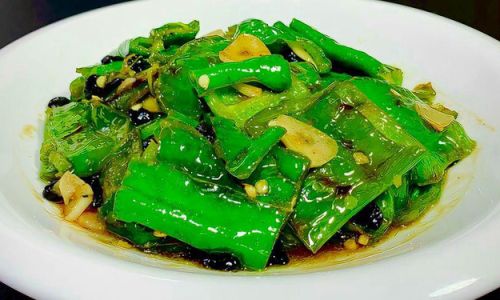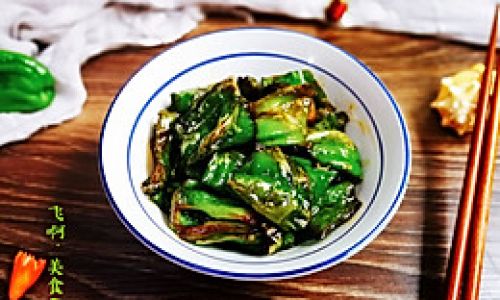Table of content
Green peppers, or qingjiao in Chinese, are a staple in kitchens worldwide, prized for their vibrant color, crisp texture, and ability to elevate even the simplest of meals. Among the myriad ways to prepare them, one dish stands out for its tantalizing combination of smoky char, tangy sweetness, and addictive umami: Tiger Skin Green Peppers. This iconic Sichuan-inspired recipe, known for the blistered, “tiger-like” pattern that forms on the pepper’s skin during cooking, is a beloved addition to family dinners, restaurant menus, and street food stalls alike. But what makes this dish truly unforgettable is its versatility—it pairs perfectly with steamed rice, noodles, or even as a standalone appetizer. In this comprehensive guide, we’ll explore the history, science, and secrets behind crafting the perfect plate of Tiger Skin Green Peppers, ensuring your next meal is a culinary triumph.
The Origins and Cultural Significance
Before diving into the recipe, let’s unravel the story behind this dish. Tiger Skin Green Peppers, or hupi qingjiao in Mandarin, trace their roots to Sichuan province, a region renowned for its bold flavors and fiery cuisine. The name “tiger skin” refers to the striking blistered appearance of the peppers, which resembles the striped fur of a tiger. This effect is achieved through a specific cooking technique: dry-frying the peppers in a hot pan until their skins char and wrinkle, creating a smoky base layer that complements the dish’s tangy-sweet sauce.

In Sichuanese homes, this dish is often served as a xiaocai (small dish) alongside rice and other hearty meals. Its popularity stems from its simplicity—requiring minimal ingredients and time—yet delivering maximum flavor. Today, it has transcended regional boundaries, becoming a global favorite among home cooks and food enthusiasts seeking a balance of heat, acidity, and texture.
The Science of Flavor: Balancing Act
At its core, Tiger Skin Green Peppers is a masterclass in flavor balance. The dish combines four key taste profiles:
- Smokiness: From the charred pepper skins.
- Sweetness: Often derived from sugar or honey.
- Sourness: Vinegar or fermented bean paste adds brightness.
- Savory Umami: Soy sauce or oyster sauce deepens the complexity.
The interplay of these elements creates a harmonious bite that keeps diners reaching for more. Additionally, the texture contrast between the crispy peppers and the sticky sauce adds another layer of satisfaction.
Ingredients: Quality Matters
To achieve restaurant-quality results, start with the freshest ingredients. Here’s what you’ll need:
For the Peppers:
- 8–10 medium green bell peppers (or similar mild peppers): Choose firm, glossy peppers with thick flesh. Avoid wrinkled or soft specimens.
- 1 tbsp cooking oil (neutral oil like vegetable or canola works best).
For the Sauce:
- 2 tbsp light soy sauce (or tamari for gluten-free).
- 1 tbsp dark soy sauce (for color and depth).
- 1 tbsp Chinese black vinegar (or substitute with balsamic or rice vinegar).
- 1 tbsp sugar (white or brown).
- 1 tsp sesame oil (optional, for nuttiness).
- 1 tsp cornstarch (mixed with 2 tbsp water to thicken the sauce).
Aromatics:
- 3 garlic cloves, minced.
- 1 tsp ginger, grated (optional).
- 1–2 dried red chilies, crushed (adjust to taste).
Optional Garnishes:
- Toasted sesame seeds.
- Chopped green onions.
- Cilantro leaves.
Step-by-Step Cooking Guide
Preparing the Peppers
Why it matters: The key to perfect tiger skin texture lies in how you handle the peppers.
- Step 1: Wash the peppers thoroughly and pat them dry. Remove the stems and seeds. For a milder flavor, keep the seeds; for less heat, discard them.
- Step 2: Using a knife, make a small slit along one side of each pepper. This allows steam to escape during cooking, preventing sogginess.
Dry-Frying the Peppers
The secret to “tiger skin”: This step requires patience and high heat.
- Step 1: Heat a large, heavy-bottomed skillet (cast iron works best) over medium-high heat. Do not add oil yet.
- Step 2: Place the peppers in the dry pan, skin-side down. Press them gently with a spatula to ensure even contact with the heat.
- Step 3: Cook for 4–5 minutes, undisturbed, until the skins blister and char. Flip occasionally to cook all sides. The goal is a deep brown color without burning.
- Step 4: Remove the peppers and set aside. Wipe the pan clean (or use a new pan) to avoid burning the sauce later.
Crafting the Sauce
Flavor layering: The sauce should cling to the peppers, not pool in the pan.
- Step 1: In a small bowl, whisk together the light soy sauce, dark soy sauce, vinegar, sugar, and cornstarch slurry. Set aside.
- Step 2: Heat 1 tbsp oil in the same pan over medium heat. Add the garlic, ginger (if using), and dried chilies. Sauté for 30 seconds until fragrant.
- Step 3: Pour the sauce mixture into the pan. Stir continuously for 1–2 minutes until it thickens into a glossy glaze.
Combining Peppers and Sauce
The finale: Toss gently to coat without bruising the peppers.
- Step 1: Add the charred peppers to the pan. Toss gently using tongs or a spatula, ensuring each pepper is coated in the sauce.
- Step 2: Cook for an additional 2 minutes, allowing the flavors to meld. Remove from heat.
- Step 3: Drizzle with sesame oil (if using) and garnish with sesame seeds, green onions, or cilantro.
Pro Tips for Perfect Results
-
Adjust the Heat:
- For extra spice, add fresh chili peppers or a dash of chili oil.
- For a mild version, omit the dried chilies and use sweet bell peppers.
-
Avoid Sogginess:

- Ensure the pan is hot before adding the peppers.
- Do not overcrowd the pan; cook in batches if needed.
-
Texture Tricks:
- For extra crispiness, briefly deep-fry the peppers instead of dry-frying.
- If the sauce is too thick, add a splash of water or broth.
-
Make-Ahead Friendly:
The peppers can be charred and stored in the fridge for up to 24 hours. Finish with the sauce just before serving.
Variations and Adaptations
One of the joys of Tiger Skin Green Peppers is its adaptability. Here are creative twists to suit any palate:
-
Vegan Version:
- Substitute oyster sauce with mushroom-based soy sauce.
- Use agave syrup instead of honey.
-
Meat Lover’s Twist:
Stir-fry ground pork or beef with the aromatics before adding the sauce.
-
Cheese Pairing:
Sprinkle grated Parmesan or feta over the finished dish for a salty kick.
-
Fermented Flavors:

Add a spoonful of doubanjiang (fermented broad bean paste) to the sauce for depth.
Serving Suggestions
Tiger Skin Green Peppers shine when paired with:
- Steamed Jasmine Rice: The sauce seeps into the grains, creating a comforting meal.
- Noodles: Toss with chilled soba noodles for a refreshing summer dish.
- Grilled Proteins: Serve alongside teriyaki salmon or garlic butter shrimp.
- Lettuce Wraps: Use the peppers as a filling for crunchy, low-carb wraps.
Troubleshooting Common Issues
-
Peppers Turn Out Soggy:
- Cause: Overcrowding the pan or insufficient heat.
- Fix: Use a larger pan and ensure the oil is hot before adding the peppers.
-
Sauce Is Too Salty:
- Cause: Excess soy sauce.
- Fix: Balance with a pinch of sugar or a splash of vinegar.
-
No Char Marks:
- Cause: Low heat or moving the peppers too soon.
- Fix: Increase heat and resist the urge to flip prematurely.
The Health Angle
Beyond its flavor, Tiger Skin Green Peppers offers nutritional benefits:
- Vitamin C Boost: Green peppers are rich in immune-boosting vitamin C.
- Low-Calorie: A serving provides fiber and nutrients without excess calories.
- Antioxidants: The charring process creates compounds that may reduce inflammation.
Cultural Context: Beyond the Plate
In China, Tiger Skin Green Peppers is more than a dish—it’s a symbol of resourcefulness. Historically, peppers were abundant and affordable, making this recipe a staple during lean times. Today, it embodies the Sichuanese philosophy of xiang la (fragrant spiciness), where heat is a tool to enhance, not overwhelm, other flavors.
Conclusion: A Dish to Savor
Mastering Tiger Skin Green Peppers is a rite of passage for any home cook. Its blend of smokiness, sweetness, and spice reflects the essence of Sichuanese cuisine—bold yet balanced, humble yet unforgettable. Whether you’re a novice in the kitchen or a seasoned chef, this recipe invites creativity and rewards patience. So fire up your stove, embrace the sizzle, and let the tiger’s roar come alive in your kitchen. Your taste buds—and your dinner guests—will thank you.





0 comments